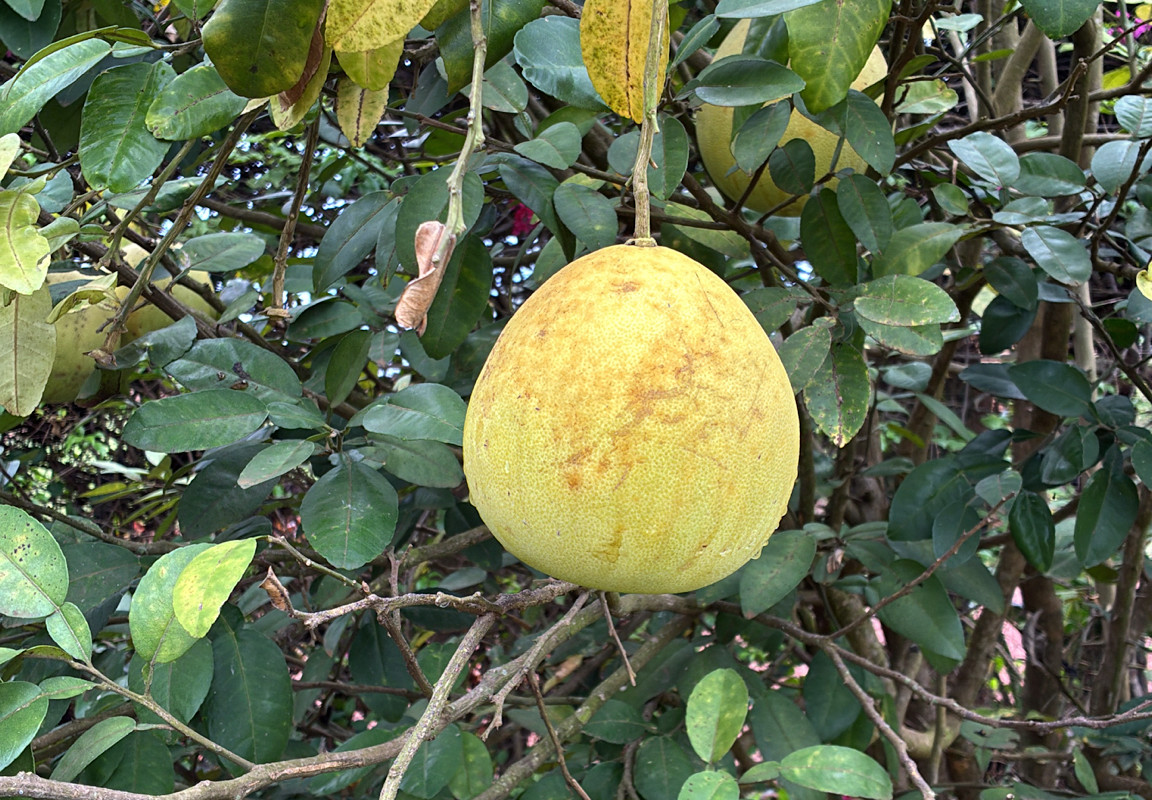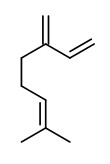Citrus maxima (Burm.) Merr. - syn. Citrus grandis Osbeck; Citrus decumana (L.) L.; Citrus aurantium var. grandis L. - Rutaceae - pomelo, pummelo, jabong, shaddock, pamplemousse (fr.), Pomelo, Pampelmuse, Pummelo
Tree, native to Southeast Asia (Malaysia, Indonesia), widely cultivated in tropics and subtropics; branches usually purplish, flat with ridges when young; leaves broadly ovate or elliptic, petiole winged; flower buds purplish or rarely milky white, flowers solitary or in racemes, calyx 3-5-lobed, petals 1.5-2cm; fruits yellowish green to pale yellow, globose, or pyriform, usually more than 10 cm in diam.
https://npgsweb.ars-grin.gov/gringlobal/taxonomydetail.aspx?10744
http://www.efloras.org/florataxon.aspx?flora_id=2&taxon_id=242412666
„The fruit tastes like a sweet, mild grapefruit… , although the typical pomelo is much larger than the grapefruit, and also has a much thicker rind. The pomelo has none, or very little, of the common grapefruit's bitterness, but the enveloping membranous material around the segments is bitter, considered inedible, and thus is usually discarded.“ wikipedia
„The pummelo… is commercally grown especially in the orient, in contrast to the grapefruit, which is recognized as a natural hybrid of the pummelo (Hodgson 1967), but grown mainly in America… Nootkatone is one of the characteristic components of th pummelo's aroma, in common with the grapefruit.“
[Sawamura, Masayoshi, and Toshinao Kuriyama. „Quantitative determination of volatile constituents in the pummelo (Citrus grandis Osbeck forma Tosa-buntan).“ Journal of agricultural and food chemistry 36.3 (1988): 567-569]
The cold-pressed peel oil (1.3-1.0% yield) of C.maxima f.Tosa-buntan from Japan contained limonene (80-83%) as the major component, and the sum of the terpene hydrocarbons (including y-terpinene, myrcene and α-pinene as major components) was likely to gradually increase during 5 months of storage. β-Cubebene (0.15-0.29%) was another increasing component, together with nootkatone (0.10-0.77%).
[Sawamura, Masayoshi, Tetsuya Tsuji, and Shigeru Kuwahara. „Changes in the Volatile Constituents of Pummelo (Citrus grandis Osbeck forma Tosa-bun tan) during Storage.“ Agricultural and Biological Chemistry 53.1 (1989): 243-246] PDF
Cold-pressed oils (CPO) of pummelo varieties contained limonene (55.4-94.1%), γ-terpinene (0.1-9.3%), and myrcene (2.2-39.3%) as main components. Each kind of pummelo was found to contain nootkatone at a considerable level (0.04-0.95%), which may be regarded as a key compound of pummelo aroma.
[Sawamura, Masayoshi, et al. „Volatile constituents of several varieties of pummelos and a comparison of the nootkatone levels in pummelos and other citrus fruits.“ Agricultural and biological chemistry 54.3 (1990): 803-805]
„γ-Terpinene was the second major component in 4 varieties, but only a minor component in the others… Multivariate analyses were applied to 37 kinds of citrus fruits including pummelos and other species. The pummelo was classified into 2 groups by cluster analysis, and into 3 groups by principal component analysis on the basis of the oxygenated composition (w/w%) in fresh CPOs. The tendency for classification agreed in the two analyses. Nootkatone was the only discriminating component of the pummelo species from others.“
[Sawamura, Masayoshi, et al. „Volatile constituents of several varieties of pummelos and characteristics among citrus species.“ Agricultural and biological chemistry 55.10 (1991): 2571-2578]
The hydrodistilled oils of C. maxima (pink and white) cultivars were rich in limonene (72.0-80.0%), dodecyl acrylate (8.0-7.2%) and nootkatone (1.6-2.5%).
[Rana, Virendra S., and Maria A. Blazquez. „Compositions of the volatile oils of Citrus macroptera and C. maxima.“ Natural product communications 7.10 (2012): 1371-1372]
Volatile extracts prepared from the peel of pummelo by cold pressing (CP), water distillation (WD), simultaneous distillation and extraction (SDE), microwave-assisted extraction (MAE), ultrasonic-assisted extraction (UAE) and supercritical CO2 fluid extraction (SFE) were analysed by sensory evaluation and GC-MS. The CP essential oil (CP-EO), MAE and UAE extracts possessed similar odour profiles to the natural pummelo odour, whereas the SDE extract and WD essential oil (WD-EO) presented the fermented/overripe and alcohol/pungent notes, and the SFE extract had a sweet note. Major volatiles were limonene, β-myrcene, β-pinene, linalool, and germacrene D.
„Analyses of odour activity values (OAVs) and cluster analysis revealed the fermented/overripe and alcohol/pungent notes of the SDE extract and WD-EO were attributed to nerol, geraniol and linalool oxide. The sweet note of the SFE extract was ascribed to citronellal and limonene oxide. Besides, a lack of limonene, neral and geranial resulted in a light green aroma of the SFE extract. This information might be valuable for further development of aromatically desirable products from citrus fruits.“
[Sun, Hao, et al. „Sensory evaluation and gas chromatography–mass spectrometry (GC‐MS) analysis of the volatile extracts of pummelo (Citrus maxima) peel.“ Flavour and fragrance journal 29.5 (2014): 305-312]

Citrus maxima, Entebbe, Uganda, USA (2025) © Adrian Rosser CC BY-SA 4.0 inaturalist.org

Citrus maxima as Citrus decumana, Duhamel du Monceau, H.L.,
Traité des arbres et arbustes, Nouvelle édition [Nouveau Duhamel], vol.7 t.42 (1819) [P.Bessa] plantillustrations.org



